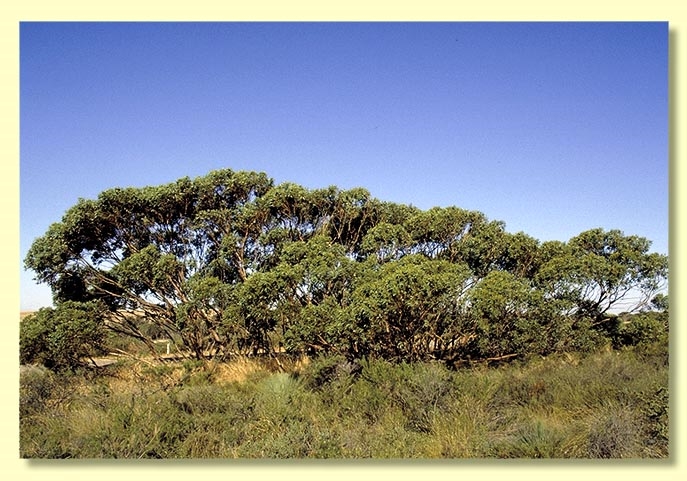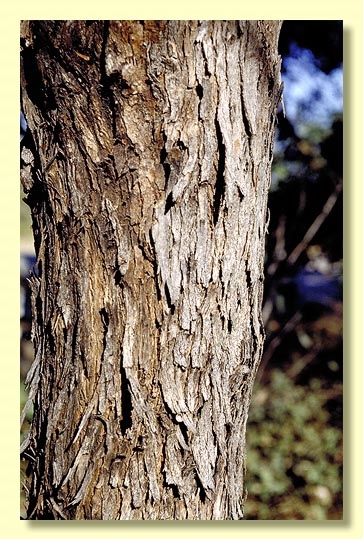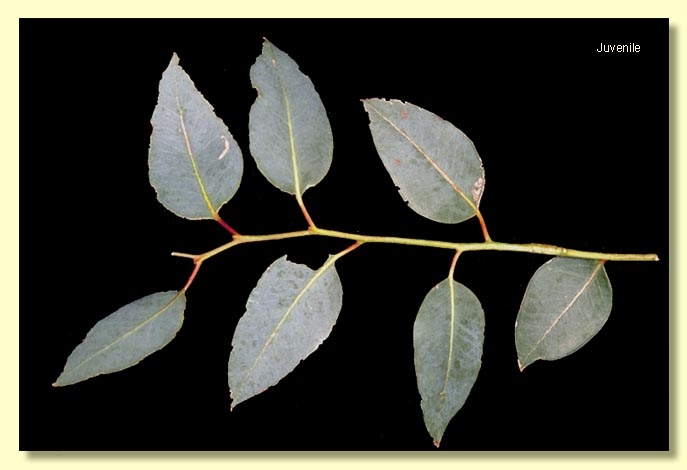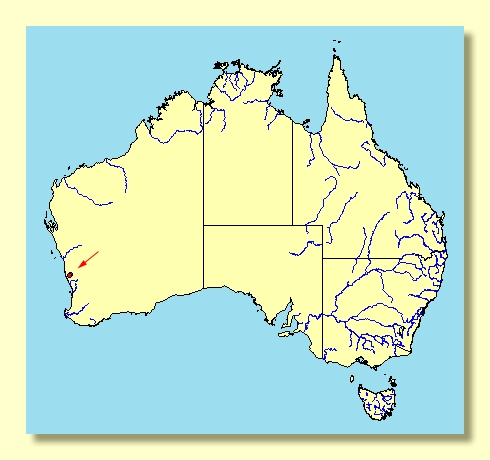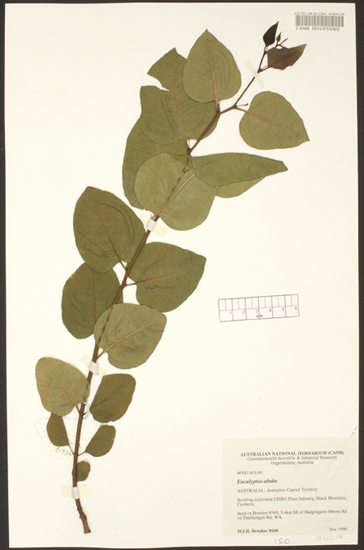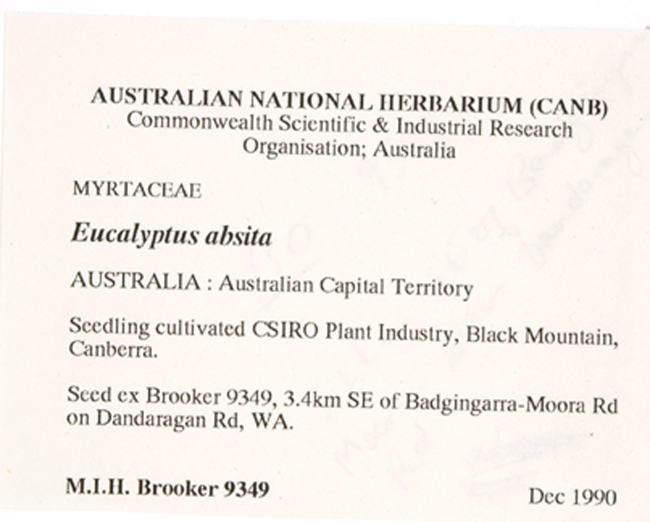Euclid - Online edition
Eucalyptus absita
Eucalyptus | Symphyomyrtus | Adnataria | Apicales | Buxeales | Amissae
Bark rough over part or all of trunks, box-type to fibrous, rarely smooth throughout, grey, yellow-grey and grey-brown, smooth above, grey over green-brown.
Branchlets lacking oil glands in the pith.
Juvenile growth (coppice or wild seedling to 50 cm tall): stems rounded in cross-section, non-glaucous; juvenile leaves always petiolate, opposite for ca 2 nodes then alternate, deltoid to ovate or elliptical, 4.5–8.5 cm long, 2–6.5 cm wide, dull blue to bluish green (but not glaucous), becoming lanceolate, green and glossy by 1.5 m tall.
Adult leaves alternate, petiole 1–2.2 cm long; blade lanceolate, often broadly so, 7–11 cm long, 1.5–4 cm wide, base tapering to petiole, margin entire, apex pointed, concolorous, glossy, green, side-veins greater than 45° to midrib, reticulation dense to very dense, intramarginal vein close to margin, oil glands obscure (?absent).
Inflorescence terminal compound, peduncles 0.4–1 cm long, buds 7 per umbel, pedicels 0.2–0.5 cm long. Mature buds obovoid to pyriform, 0.4–0.6 cm long, 0.3–0.4 cm wide, scar present (outer operculum lost early), operculum rounded, stamens inflexed, outer filaments without anthers or anthers small and poorly formed (staminodes), inner stamens fertile, filaments shorter, anthers with more or less cuboid to globose, scarcely versatile, sub-dorsifixed, dehiscing by short subterminal slits or pores, style long and straight, stigma blunt to pinhead-shaped, locules 4, the placentae each with 4 vertical rows of ovules. Flowers cream.
Fruit on pedicels 0.2–0.4 cm long, obconical to cupular, 0.4–0.5 cm long, 0.4–0.6 cm wide, rim thin, disc descending more or less obliquely, valves 4, enclosed.
Seeds dark brown, 0.8–2 mm long, flattened-ovoid, dorsal surface shallowly reticulate, hilum ventral.
Cultivated seedlings (measured at node 10): cotyledons reniform; stems more or less square in cross-section; leaves always petiolate, opposite for 4 or 5 nodes then alternate, deltoid to ovate, 4–6.5 cm long, 2.5–5.5 cm wide, dull, greyish green.
Flowering has been recorded in June and November.
A mallee endemic to Western Australia known only from three small stands in the Badgingarra and Dandaragan area north of Perth. It has fibrous to box-type bark for up to 2 m or is in small plants completely smooth. Adult leaves are glossy green and buds are at the ends of branchlets (terminal).
Eucalyptus absita belongs in Eucalyptus subgenus Symphyomyrtus section Adnataria (the boxes) because the buds have two opercula, ovules are in four rows, seeds are flattened-ovoid, cotyledons are reniform, and anthers are rigid on the staminal filaments. Within section Adnataria, E. absita is part of a subgroup, series Buxeales, further distinguished by being partially rough-barked, having terminal inflorescences and buds that lose the outer operculum early. Most species in series Buxeales are found in south-eastern Australia, with only three occurring in Western Australia, viz. E. cuprea, E. absita and E. lucasii. All three have inflexed stamens the outermost of which are imperfect (staminodes), features separating them to some extent from the eastern species.
Eucalyptus absita is closest to E. cuprea but differs in the distinctly deltoid to ovate, blue to blue-green juvenile leaves (ovate, greenish in E. cuprea), thin-rimmed fruit with the disc conspicuously broad and obliquely descending (vertically descending in E. cuprea) and the autumn-winter flowering (spring for E. cuprea). E. lucasii differs from both E. absita and E. cuprea in the predominantly smooth bark, dull not glossy adult leaves and arid zone distribution.
Eucalyptus absita is listed as "Endangered" under the Australian Government Environment Protection and Biodiversity Conservation Act 1999 (EPBC Act). Further information may be found at this web address:
http://www.environment.gov.au/cgi-bin/sprat/public/sprat.pl

